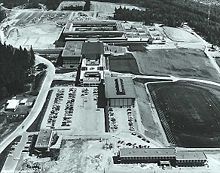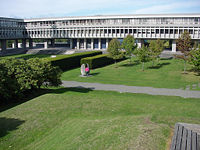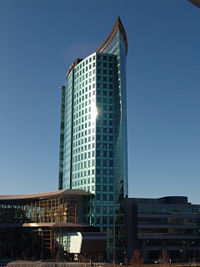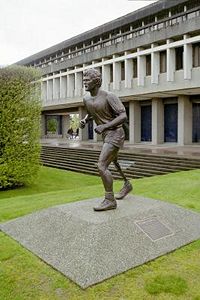Simon Fraser University
| Simon Fraser University | |
|---|---|
|
|
|
| Motto: | Nous sommes prêts |
| Motto in English: | We are ready |
| Established: | 1965 |
| Type: | Public University |
| Endowment: | $176.902 million [1] |
| Chancellor: | Dr. Brandt C. Louie |
| President: | Dr. Michael Stevenson |
| Provost: | Dr. Jon Driver |
| Students: | 28,207 [2] |
| Undergraduates: | 25,009 |
| Postgraduates: | 3,198 |
| Location: | |
| Campus: | Urban, 1.7 km² maintained, plus 3.3 km² of SFU community |
| Satellite Campuses: | Downtown Vancouver , Surrey , Vancouver and Burnaby, British Columbia |
| Colours: | blue & Red |
| Nickname: | Simon Fraser Clan |
| Mascot: | McFog the Dog |
| Affiliations: | AUCC, IAU, ACU,CIS, CUSID,CWUAA |
| Website: | www.sfu.ca |
Simon Fraser University (SFU) is a public university in British Columbia with its main campus on Burnaby Mountain in Burnaby, and satellite campuses in Vancouver and Surrey. The university was named after Simon Fraser, a North West Company fur trader and explorer. Undergraduate and graduate programs operate on a year-round tri-semester schedule.[3] The campus was noted in the 1960s and early 1970s as a hotbed of political activism, culminating in a crisis in the Department of Political Science, Sociology, and Anthropology in a dispute involving ideological differences among faculty. The resolution to the crisis included the dismantling of the department and its breaking-up into today's separate departments.[4]
SFU is ranked 1st with UVic in Canada’s top Comprehensive Universities in 2008's Macleans Magazine[5], ranked 68th in the world and 4th in Canada in 2008 Ranking of World Universities.[6] It was established in 1965 and presently has more than 25,000 undergraduate students.[7]
Contents |
History

Founding
Simon Fraser University was founded upon the recommendation by a 1963 a report entitled Higher Education in British Columbia and a Plan for the Future, by Dr. J.B. Macdonald, who recommended the creation of a new university in the Lower Mainland. The British Columbia Legislature gave formal assent two months later for the establishment the university. In May of the same year Dr. Gordon M. Shrum was appointed as the university's first Chancellor. From a variety of sites which were offered, Shrum recommended to the Provincial Government that the peak of Burnaby Mountain be chosen for the new university. Architects Arthur Erickson and Geoffrey Massey won a competition to design the university, and construction began in the spring of 1964. Eighteen months later, on September 9, 1965, the university began its first semester with 2,500 students.
Coats of Arms
The school's original coat of arms was used from the university's inception until 2006, at which point the Board of Governors voted to adapt the old coat of arms and thereby register a second coat of arms. The adaptation replaced two crosslets with books after some in the university asserted the crosses had misled prospective foreign students into believing SFU was a private, religious institution rather than a public, secular one.[8] In 2007, the university decided to register both the old coat of arms and the revised coat of arms featuring the books. In 2007, a new marketing logo was unveiled, consisting of white letters on block red.[9]
Academics
Profile
SFU has been rated as Canada's best comprehensive university (in 1993, 1996, 1997, 1998, 2000 and 2008) in the annual rankings of Canadian universities in Maclean's magazine and has consistently placed at or near the top of the publication's national evaluations. Research Infosource, Canada’s leading provider of research intelligence evaluation, named SFU the top comprehensive university in Canada for “publication effectiveness” in 2006. Similar to most Canadian universities, SFU is a public university, with more than half of funding coming from taxpayers and the remaining from tuition fees. The university's faculties are divided into six areas:Applied Sciences, Arts and Social Sciences, Business Administration, Education, Health Sciences, and Science.
Undergraduate
SFU is home to over 25,000 undergraduates and 3,198 graduate students. The university has grown in recent years recently achieving an alumni population of over 100,000. It has 911 faculty members and 3,403 staff. International students make up 7% of its student body. (University Community Report (2006/2007)).[10] SFU's student union is known as the Simon Fraser Student Society (SFSS), which includes everyone who studies at SFU. It was a member of the Canadian Federation of Students, but students voted in a referendum in March 2008 to leave the organization.

Instructors
Teaching Assistants, Tutor Markers, Sessional Instructors, and Language Instructors at SFU are unionized. The union, The Teaching Support Staff Union (TSSU), is independent. Faculty and lecturers are members of the Faculty Association. Staff are members of the Canadian Union of Public Employees (CUPE), the Administrative and Professional Staff Association (APSA), or Polyparty. A few positions at the university such as some in Human Resources and senior administrative positions fall outside of the five associations or unions above.
Research and Affiliations
SFU also works with other universities and agencies to operate joint research facilities. These include Bamfield Marine Station, a major centre for teaching and research in marine biology; TRIUMF, a powerful cyclotron used in subatomic physics and chemistry research; MITACS, headquarters of this Network of Centres of Excellence for 26 universities and 75 companies. SFU is also a partner institution in Great Northern Way Campus Ltd in Vancouver. In March 2006, SFU approved an affiliation agreement with a private college for international students to be housed adjacent to its Burnaby campus. This new college named Fraser International College is now open in the Multi Tenant Facility located in Discovery Parks Trust SFU site.[11]
Campuses

Simon Fraser University has three campuses, each located in different parts of the Lower Mainland. SFU's main campus is located in Burnaby, atop Burnaby Mountain. Two satellite campuses are located in Vancouver's Downtown at Harbour Centre, and in Surrey. The downtown campus has expanded to include several other buildings in recent years , including the Segal Graduate School of Business, now known officially as SFU Vancouver.
SFU Burnaby Mountain Campus
The main campus is located atop Burnaby Mountain, at an elevation of 365 metres. The library on the main campus is called the W. A. C. Bennett Library, named after the Social Credit Premier of B.C. who established it. In addition to the renowned architectural designs, a significant portion of the campus is located underground. The campus has a theatre, a Museum of Archeology and Ethnology and three art galleries.

Libraries, museums and galleries
The SFU Burnaby Campus has a single library called the WAC Bennett Library which holds over 2 million published books, and 6000 print subscriptions. Along with the UniverCity development agreement, residents of UniverCity are also allowed to borrow books from the library. An additional art gallery is located inside the library. SFU also has a Museum of Archeology and Ethnology, which holds many exhibits on lease from the Royal British Columbia Museum in Victoria. The exhibits are created by students as part of the museum studies courses offered in the Department of Archaeology. Archaeological collections arising from excavations and other research by faculty, staff and students are also housed in the museum.
Also located at the SFU Library is the Electronic Document Centre, which provides internet access to digitized documents from a number of archival collections, such as Harrison Brown's Xi'an Incident collection,[12] and the history of British Columbia and Western Canada in general, including documents from the Doukhobor migration from the Russian Empire to Saskatchewan and then to British Columbia assembled for donation to the university by John Keenlyside [13]
SFU Residences
The SFU Burnaby campus has six different residence housing units: The Towers, Madge Hogarth House, McTaggart-Cowan Hall, Townhouse Complex, Hamilton Hall and the Louis Riel House.
Olympic Speed Skating Oval
The main campus was originally selected to be the site of a world-class speed skating oval for the 2010 Winter Olympics; however, the 2010 organizing committee altered its decision and decided it will now be built in the nearby city, Richmond, British Columbia.

SFU Surrey Campus
SFU Surrey is a satellite campus of Simon Fraser University. SFU Surrey is located in Central City, an award-winning[14] architectural complex adjacent to the Surrey Central SkyTrain station. It was established in order to absorb the students and programs of the former Technical University of British Columbia which was closed by the provincial government. It has since expanded to house the Surrey operations of other SFU programs. The Central City complex that houses the complex was designed by architect Bing Thom. Established in the spring of 2002, the campus offers undergraduate studies in arts and social sciences, applied sciences, business administration, education, mathematics, and science; graduate and professional studies in applied sciences and education; and a number of credit and non-credit continuing education courses.
Programs at the SFU Surrey campus are offered by the Faculties of Applied Science, Arts and Social Sciences, Business Administration, Education, and Science. SFU Surrey currently offers three first-year cohort programs: TechOne, Science Year One and Explorations in the Arts and Social Sciences. Surrey is the home base for SFU's new and innovative World Literature Program. The campus also provides degrees in the sections of its business faculty, computer science faculty, and its own School of Interactive Arts and Technology (SIAT) [15].

SFU Harbour Centre Vancouver
The university pioneered university mid-career professional education in Vancouver in the early 1980s with the launch of a store-front centre. It was created as the result of a close collaboration between the University and the business, professional and cultural communities, the City of Vancouver and the Province of British Columbia. A significant portion of funding for the building campus came through the private sector. The Vancouver campus became the first university campus located in downtown Vancouver. SFU's downtown Vancouver campus has four distinct sites: Harbour Centre, the Morris J Wosk Centre for Dialogue, the Segal Graduate School of Business, and the school for the contemporary arts has studio space. The entire downtown campus was re-built and revitalized in the late 1980s and officially opened as SFU’s Vancouver campus on May 5, 1989. The campus serves over 70,000 people annually. Approximately 10,000 are students enrolled in courses at the campus. In 2008, the School for the Contemporary Arts moved its Burnaby campus programs to the Vancouver campus and occupied a new facility on the redeveloped Woodward’s site.[16]
Woodward's building, SFU Centre for Contemporary Arts
In 2009, the School for the Contemporary Arts will move its Burnaby campus programs to the Vancouver campus and occupy a new facility under construction on the redeveloped Woodward's building site. The new SFU facility will be over 130,000 square feet and be part of one of the most inclusive social experiments in the history of Canada. The New Woodward's building project will include not only SFU, but also 200 units of social housing, 536 units of market housing, retail, community space, daycare and a significant series of public spaces, totalling 1 million square feet.
Canadian Centre for Studies in Publishing
The CCSP is a teaching, research, and information centre based at Simon Fraser University Vancouver's Harbour Centre building. Founded in 1987, the CCSP is a university/industry initiative dedicated to the development of publishing in Canada and internationally. It is advised by an industry board and emphasizes book, magazine, and web publishing.
UniverCity residential development

At present, the part of Burnaby Mountain below SFU is a park and conservation area. Apart from SFU and associated industrial/technical research park Discovery Park, there had been little development until recently. In 2003, the university commenced construction on a new residential and commercial area occupying approximately 200 acres adjacent to the campus, atop the mountain, called UniverCity. The area will contain up to 4,500 residential units in a number of neighbourhoods, along with a new town centre, schools, parks and other amenities. As of January 2008, approximately 1200 residences, and The Cornerstone building, which includes restaurants, shops, services and rental apartments are complete. Construction of another two mid-rise residential buildings (141 homes), a mixed-use building similar to The Cornerstone, and a 1400 car multi-level parkade will begin Spring 2007. The development is noted for the first community transit pass program in Canada, and a prohibition on multi-national retailers in the town centre.[17]
Student Life and Athletics

The student newspaper The Peak was established shortly after the university opened, and is circulated throughout the Lower Mainland. CJSF-FM radio is the school's radio station, broadcasting from 90.1 FM to Burnaby and surrounding communities, online at www.cjsf.ca or on cable at 93.9 FM. The school's sports teams are called the Simon Fraser Clan, and the mascot is a Scottish Terrier named "McFog the Dog". In sports and other competitions, there tends to be a strong rivalry between SFU and The University of British Columbia.
SFU's Clan Athletics competes in Canadian Interuniversity Sport (CIS) and the U.S. National Association of Intercollegiate Athletics (NAIA). SFU has 14 varsity sport teams and 300 athletes. Football, men's and women's basketball, women's volleyball and women's wrestling compete for CIS championships only. Men's and women's soccer, women's softball, men's and women's swimming, men's and women's cross-country and men's and women's track and field compete for NAIA championships only. Men's wrestling competes for championships of both organizations. SFU has won the NAIA NACDA Director's Cup five times, among others[18].
Many SFU athletes have also participated in Olympic Games, including medal winners Carole Huynh, Daniel Igali, Jay Triano, Jeff Thue, Sue Holloway, Bob Molle, Chris Rinke, Hugh Fisher, Garry MacDonald, and Bruce Roberston.
There are also a few "elite clubs" at Simon Fraser University which are teams that compete competitively against other university teams at their varsity level. These teams include the SFU Rowing Team, the SFU Lacross Team, SFU Hockey team and the SFU Cheerleading Team.
Transportation

The relatively remote location of SFU's main campus has long posed a transportation problem for its student body. This situation has, however, been significantly improved by the recent expansion of the Vancouver SkyTrain rapid transit system and the introduction of a low-fare university fare card, the U-Pass. The university community is now served by the Production Way-University and Sperling-Burnaby Lake SkyTrain stations. Most Simon Fraser students are commuters who live in the area, but residence housing facilities accommodate nearly 2,200. The final tower of a new three building residence project opened in the Fall of 2005 at the Burnaby campus. The downtown Harbour Centre campus is across from the Waterfront SkyTrain station. The SFU Surrey campus is at the Central City development next to the Surrey Central SkyTrain station.
Governance and administration
Convocation
The Convocation is composed of all faculty members, senators, and graduates (degree holders, including honorary alumni) of the university. Its main function is to elect the Chancellor (who acts as Chair of Convocation) and four Convocation Senators. Convocation ceremonies are held annually to confer degrees (including honorary degrees) as well as award diplomas and certificates.

Board of Governors
The Board is composed of the Chancellor, the President, two student members, two faculty members, one staff member, and eight individuals appointed by the British Columbia government. Traditionally, the Board is chaired by one of the government appointees. The Board is responsible for the general management and governance of the university.
Senate
The Senate is composed of the Chancellor, the President, Vice-President, Academic, Vice-President, Research, Deans of Faculties, Dean of Graduate Studies, Dean of Continuing Studies, Associate Vice-President, Academic, University Librarian, Registrar (as Senate secretary), 14 student members, 28 faculty members, and 4 convocation members (who are not faculty members). The Senate is chaired by the President. The academic governance of the university is vested in the Senate.
Chancellor
The Chancellor is elected by and from Convocation for a three-year term, which can be renewed once. The main responsibilities of the Chancellor are to confer degrees and represent the university in formal functions.
President and Vice-Chancellor
The President and Vice-Chancellor is appointed by the Board of Governors based on a selection process jointly established by the Board of Governors and the Senate of the university. As Chief Executive Officer and Chair of Senate, the President is responsible for the day-to-day administration of the university.
Dean of Graduate Studies Office
The Dean of Graduate Studies Office is responsible for ensuring compliance to approved graduate studies standards, administering merit-based graduate awards and maintaining formal student records.
Alumni

Locally and internationally famous alumni include ex-B.C. Lion and Canadian football Hall-of-Famer Lui Passaglia, FOX News and CNN TV personality and political commentator Rachel Marsden, Olympic wrestler and politician Daniel Igali, artist David Usher, former Chinese Interntional pageant winner and renowned Asian actress Sonija Kwok, photographer and former spouse of Prime Minister Pierre Trudeau, Margaret Trudeau, British Columbia Premier Gordon Campbell, and former Premiers Glen Clark and Ujjal Dosanjh. Minh Le, while in his last year as a Computing Science student at the university, co-created the popular spin-off from the Half-Life series of computer games, Counterstrike. Current Vancouver Canucks owner Francesco Aquilini graduated from Simon Fraser University with a degree in Business Administration. He is the Managing Director of Vancouver-based Aquilini Investment Group and is the current owner of the Vancouver Canucks and GM Place. Right-wing political analyst Rachel Marsden also graduated from SFU in the 1990s after a sexual harassment scandal with a swim coach. The incident, which led to the resignation of President John Stubbs, is one of the most highly publicized incidents ever to take place at SFU.
Terry Fox
One of the most highly regarded SFU alumnus and one of Canada's most treasured sons is Terry Fox. When Terry was an 18-year-old Kinesiology student and junior varsity basketball player he was diagnosed with bone cancer, which resulted in the amputation of his leg. With a prosthetic leg, Fox set out to cross Canada on a grueling run called the Marathon of Hope to raise funding and awareness about cancer. As a result of Terry Fox's legacy, running for charitable causes is now integrated within communities worldwide. He also inspired friend Rick Hansen's Man in Motion world tour by wheelchair. In 2001, SFU awarded an honorary degree to Betty Fox, mother of Terry Fox and Honorary Chair of the Terry Fox Foundation.
Honorary alumni
In 1967, SFU awarded an honorary LL.D. (doctor of laws) to Marshall McLuhan, the first honorary degree awarded at university[19]. On April 20, 2004, SFU conferred honorary degrees upon three Nobel Peace Prize recipients: the 14th Dalai Lama, Bishop Desmond Tutu, and human rights activist Shirin Ebadi. At each convocation, SFU awards honorary degrees to various people from around the world for their activities and pursuits. Other honorary alumni include skier Nancy Greene Raine, Milton Wong, Doris Shadbolt, dancer and choreographer Judith Marcuse, economist Jeffrey Sachs, Peter Gzowski, Douglas Coupland, Romeo Dallaire, Canadian businessman Stephen Jarislowsky, Iain Baxter, Cary Fowler, Martha Piper, and Rick Hansen.[20]
Appearances in popular culture
Due to the contemporary architecture of the Academic Quadrangle, the main campus has been used for location shots in science fiction television series such as Stargate SG-1 and Battlestar Galactica. Its first use as a film set was for the 1972 science fiction film The Groundstar Conspiracy, in which the entire campus complex was used. The AQ also served as a backdrop for shots of "headquarters" in the television series The X-Files. Recently, in addition to other Vancouver-area landmarks, many parts of the Burnaby campus were used for the filming of the movie The 6th Day as well as "Agent Cody Banks". In early 2008, the Burnaby campus was again used for filming, this time for The Day the Earth Stood Still (2008 Remake). Ashton Kutcher was also recently sighted on campus filming in the Criminology Department. Exterior shots of the campus AQ have also been used in the vancouver-based tv series J-Pod (based on the book).
See also
- History of Simon Fraser University
- Simon Fraser Student Society
- Applied Foresight Network
- The Peak
- List of universities in British Columbia
- Higher education in British Columbia
- Education in Canada
- Woodward's building
- CJSF-FM
References
- ↑ SFU March 2008 financial statement
- ↑ SFU Facts
- ↑ Simon Fraser University
- ↑ http://www.peak.sfu.ca/gopher/94-3/issue4/another.ans
- ↑ "Maclean's Comprehensive University Rankings" (PDF).
- ↑ "Webometrics Ranking of Canadian Universities".
- ↑ SFU Facts - Stats and graphs
- ↑ SFU News Online - SFU's new coat of arms - February 07, 2007
- ↑ SFU News Online - SFU launches new brand - February 07, 2007
- ↑ http://www.sfu.ca/facts/stats.html
- ↑ http://www.cknw.com/news/news_local.cfm?cat=7428218912&rem=32389&red=80121823aPBIny&wids=410&gi=1&gm=news_local.cfm
- ↑ Harrison Brown: The Sian Incident and Beyond
- ↑ The Doukhobor Collection "AQ Magazine", June 2001
- ↑ Award-winning SFU Surrey
- ↑ http://www.siat.sfu.ca
- ↑ About SFU Vancouver
- ↑ http://www.translink.bc.ca/About_TransLink/News_Releases/news12200501.asp
- ↑ http://www2.sfu.ca/athletics/ other awards
- ↑ SFU 2008 Honorary Degree Recipients
- ↑ Truth as a Measure of Life and Politics - aq November 2004
External links
|
||||||||||